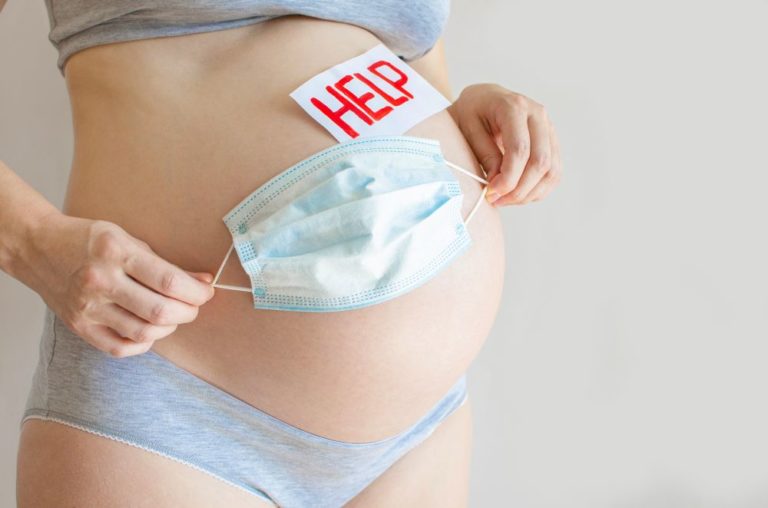In spring 2020, the pandemic began shutting down the world—restaurants, colleges, even entire cities felt emptied and closed. A cloud of uncertainty lingered over most parts of the world and altered our daily schedules and tasks. But for a wide segment of society, it wasn’t the toilet paper, or the masks, or the isolation from their families that hurt the worst—it was the sudden uncertainty around one of the most fundamental aspects of our lives: reproduction.
Quite suddenly, with the onset of the pandemic, this process, already fraught with dangers and questions and challenges, became infinitely more so. Hard data was already scarce in an active, novel pandemic, and for pregnancy, even more so. In some cases, the answer became delay or cancel any family plans. Birth rates, already on the decrease, abruptly plummeted in the United States. According to a recent survey by the Guttmacher Institute, 34% of American women have either delayed their plans to have a child or reduced the number of children they expect to have as a result of the pandemic [1].
For those who elected to move forward, they faced an environment of heightened risk. Rates of maternal deaths, stillbirths, ruptured ectopic pregnancies, and maternal depression shot up around the world during the pandemic [2]. Health officials are scrambling to understand if this is directly related to the virus, or just a byproduct of a global health care system stretched to the brink. In the meantime, both women and men, intentionally and not, continue to make and have babies, navigating the winding path of conception, pregnancy, and birth, all in an active pandemic. However, there are still many more questions and few certainties when it comes to nurturing new life.
Making babies
One of the more intriguing questions about the COVID-19 pandemic is the fact that from the start, it has hit men harder than women. Maleness is, in fact, the leading risk factor for both contracting the virus, and developing severe illness once infected [4]. This is due to the prevalence ACE2, a protein found on the surface of many types of cells that acts as the receptor for COVID-19’s spike protein. Though ACE2 is found in both men and women, a lot of it is found in the testes, more, in fact, than in any other organ, male or female [3]. That has reproductive health specialists concerned that the virus might impact sperm production [4]. In fact, COVID-19’s viral cousin, SARS, or SARS-CoV, is known to cause widespread damage to both the sperm and testes when it invades, causing severe inflammation and cell death [5], and aside from that, it isn’t unusual for sperm production to suffer during a fever-inducing illness.
Sarah Vij, a urological surgeon and male fertility specialist at the Cleveland Clinic in Cleveland, OH, said that recently ill men are routinely advised not to undergo fertility treatments due to inevitable drops in sperm counts (Figure 1). Anecdotally, she said, “I’ve seen two patients and my partner has seen one who were recovering or recently infected with COVID who had no sperm in their ejaculate,” she said, but it’s unclear whether or not this is a prolonged issue or merely temporary. The data simply do not exist to suggest either way.
Some men have reported scrotal discomfort following an infection, which could suggest damage to the testes, and that could be long-lasting. Autopsy studies of men who died from COVID in both Brazil and China showed significant testicular inflammation and cell damage, but the sample size remains too low to any determinations one way or another [5]. Vij, however, is optimistic. “The testicles are pretty resilient,” she said. Most patients make a full recovery following major insults after cancer treatments like chemotherapy and radiation, and so she suspects that the fertility impacts from this virus, like other viral illnesses, will only be temporary.

Growing babies
Women may be overall better off than men in terms of contracting COVID and developing serious illness—but that becomes a little less true for pregnant women. According to a Centers for Disease Control and Prevention (CDC) report, pregnant or recently pregnant women are at an increased risk for severe illness [6]. One study of more than 400,000 symptomatic COVID-positive women found those that were pregnant were nearly four times as likely to require invasive ventilation, and twice as likely to die [7]. Karen Puopolo, chief of Newborn Medicine at Pennsylvania Hospital (Figure 2), said, “as with other respiratory viral diseases during pregnancy, influenza being a good example, you can have a harder time with it and get sicker when you’re pregnant than if you were the exact same person who got that exact same virus, but wasn’t pregnant.”

This vulnerability may be partially due to the fact that pregnancy limits lung capacity due to a growing uterus, which enhances the risk of developing severe pneumonia, but pregnancy also alters a woman’s immune response on a cellular level, making her more susceptible to viruses [8]. But though pregnant women may be at greater risk than nonpregnant women, severe illness rates are still lower than men. And as long as the woman has access to adequate health care with operational ventilators, she will more than likely be okay.
Unfortunately, this is not the case in many of the worst-stricken areas of the world, such as Brazil and India. A Brazilian taskforce that is studying the pandemic’s impact on pregnancy found that as of May 2021, at least 803 pregnant and postpartum women have died from the virus since February 2020 [9], and the risk of a woman dying while pregnant or during childbirth, infected or not, rose by more than a third in both Mexico and India [2]. Similar increases have been seen throughout the world [10]. The massive influx of severely ill COVID patients has also pushed pregnant women in these areas out of the hospital, limiting their access to critical prenatal care, leading to thousands of deaths that would have been avoided under different circumstances [10].
Protecting babies
Early in the pandemic it was unclear if women could transmit the virus to their babies during pregnancy, or at birth. Perhaps out of an overabundance of caution, the initial policy in China was for a newborn to be immediately removed from a COVID-mother and then kept in isolation for as long as 14 days without breastmilk. “That draconian process was not something any of us wanted to replicate,” said Puopolo, “but we were in an evidence-free zone.”
Prior to the pandemic, Puopolo had been working on a study investigating immunity transfer from mother to child for Group B Streptococcus, one of the leading causes of sepsis in newborns. By comparing antibody levels in the umbilical cord blood of newborns to those in the mother’s blood, they could get a pretty good idea of the rate of transfer from the mother through the placenta. When the pandemic hit, it was easy to adjust their protocol to test for those antibodies instead. “As newborn providers, we wanted a way to tell a woman she doesn’t have to worry anymore,” she said, “if you have to tell a family with a new baby that everybody has to wear a mask and wash their hands, and nobody can come over and nobody can help you take care of that baby, there are a lot of really terrible practical implications of this virus for pregnant women in new families.” They also hoped that with the rapid development of vaccines, this might help them get a general idea as to whether properly timing a vaccine during pregnancy might help confer immunity to the fetus.
Puopolo and her colleagues collected blood from 1471 mothers and their baby’s umbilical cords and tested them both for antibodies. Eighty-three of the mothers tested positive for COVID antibodies, and 72 of their babies showed antibody levels at least as high or higher than their mothers [11]. “What our work established was that these antibodies are transferred, they appear to be transferred with a timing that is relatively rapid relative to when the woman gets the disease,” said Puopolo. And furthermore, the data suggest that the earlier a mother is infected, the greater the transfer of antibodies to the fetus, though further studies are needed to determine these precise dynamics. This hints that there may very well be an optimal time to vaccinate the mother. “Of course, this isn’t the only thing an obstetrician has to think about when counseling a patient,” said Puopolo, “but we now at least have some information to provide to care providers about the best time during pregnancy to immunize.”
This presumes a pregnant mother even can get immunized. Vaccine safety in pregnant women has been slow to come. That’s because, historically, pregnant women have long been excluded from clinical trials to protect both mother and child from ill effects. Sadly, in the case of the pandemic, this left one of the most vulnerable populations without basic safety information. Fortunately, that is all finally beginning to change. Formal clinical studies with pregnant women for both the Moderna and Pfizer vaccines are currently underway, and preliminary data on more than 35,000 people showed no obvious safety issues from those vaccines in pregnant women [12]. It remains unclear if other vaccines, particularly those that are more widely available outside of the United States, like Covishield from AstraZeneca and Covaxin, are safe for pregnant women, leaving many expectant mothers at risk.
Life prevails
If there can be said to be a gift in this pandemic, it is in how relatively less it affects children—and that so far has appeared to extend to infants born over the last year. Though there have been documented cases of newborns being infected after birth, the CDC and the American Academy of Pediatrics say this is unlikely. Only 2%–4% of newborns test positive for the virus in the few days after birth, and those that do don’t get especially sick. Generally, all of them are born to mothers who are acutely ill, and likely weren’t sick enough during pregnancy to pass along immunity.

“When I think back to how worried we were at the beginning of the pandemic,” said Valerie Flaherman, associate professor of Pediatrics and Epidemiology and Biostatistics at the University of California San Francisco Medical Center (Figure 3), “there were so many things about COVID that were difficult to understand, and we were all really worried the babies would have a lot of deleterious impacts.” Flaherman, in a study looking at babies born to infected women, found that, “in general, the babies did well.” But, she said, we have yet to see comprehensive data from babies born to women infected early in pregnancy. Other viruses, like Zika and Rubella, are known to cause severe birth defects and perhaps even cognitive, behavioral, and psychiatric disorders that may not be obvious until later in life [13]. “Most of the time,” said Puopolo, “the issues with all of these viruses occur during a very narrow period early in pregnancy where there’s very rapid organ development in the baby.” It’s still too early to know if the virus is capable of similar effects—something Flaherman is currently investigating.
Though much has been learned in these pandemic-laden months, there are still merely hints and clues about the effects of COVID-19 on reproductive health. And for some, there is no time to waste. “My experience is when it comes to fertility, patients do not want to wait,” said Vij. Her practice never really slowed down, even at the height of the pandemic.
References
- L. D. Lindberg et al., “Early impacts of the COVID-19 pandemic: findings from the 2020 Guttmacher survey of reproductive health experiences,” Guttmacher Institute, New York, NY, USA, 2020.
- B. Chmielewska et al., “Effects of the COVID-19 pandemic on maternal and perinatal outcomes: A systematic review and meta-analysis,” Lancet Global Health, vol. 9, no. 6, E759–E772, Jun. 2021.
- C. M. Seymen, “The other side of COVID-19 pandemic: Effects on male fertility,” J. Med. Virol., vol. 93, no. 3, pp. 1396–1402, Mar. 2021.
- T. T. Meng, R. J. Dong, and T. G. Li, “Relationship between COVID-19 and the male reproductive system,” Eur. Rev. Med. Pharmacol. Sci., vol. 25, no. 2, pp. 1109–1113, Jan. 2021.
- A. Abdel-Moneim, “COVID-19 pandemic and male fertility: Clinical manifestations and pathogenic mechanisms,” Biochemistry (Moscow), vol. 86, no. 4, pp. 389–396, Apr. 2021.
- Centers for Disease Control and Prevention, Breastfeeding and Caring for Newborns. Accessed: May 7, 2021. [Online]. Available: https://www.cdc.gov/coronavirus/2019-ncov/need-extra-precautions/pregnancy-breastfeeding.html
- L. D. Zambrano et al., “Update: Characteristics of symptomatic women of reproductive age with laboratory-confirmed SARS-CoV-2 infection by pregnancy status – United States, January 22–October 3, 2020,” MMWR—Morbidity Mortality Weekly Rep., vol. 69, no. 44, pp. 1641–1647, 2020.
- H. Liu et al., “Why are pregnant women susceptible to COVID-19? An immunological viewpoint,” J. Reprod. Immunol., vol. 139, p. 103122, Jun. 2020.
- F. Milhorance, “‘Calamity of maternal deaths’: COVID concern grows for Brazil’s pregnant,” Guardian, May 2021 [Online]. Available: https://www.theguardian.com/global-development/2021/may/03/calamity-of-maternal-deaths-covid-concern-grows-for-brazils-pregnant.
- J. Villar et al., “Maternal and neonatal morbidity and mortality among pregnant women with and without COVID-19 infection: The INTERCOVID multinational cohort study,” JAMA Pediatr., e211050, Apr. 2021, doi: 10.1001/jamapediatrics.2021.1050.
- D. D. Flannery et al., “Assessment of maternal and neonatal cord blood SARS-CoV-2 antibodies and placental transfer ratios,” JAMA Pediatr., vol. 175, no. 6, pp. 594–600, Jun. 2021.
- T. T. Shimabukuro et al., “Preliminary findings of mRNA COVID-19 vaccine safety in pregnant persons,” N. Engl. J. Med., vol. 384, no. 24, pp. 2273–2282, Jun. 2021.
- C. N. Cordeiro, M. Tsimis, and I. Burd, “Infections and brain development,” Obstet. Gynecol. Surv., vol. 70, no. 10, pp. 644–655, Oct. 2015.



